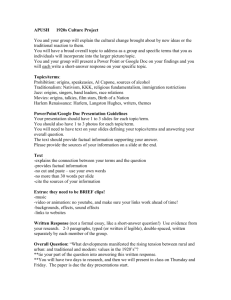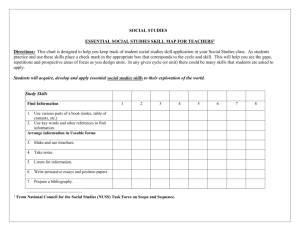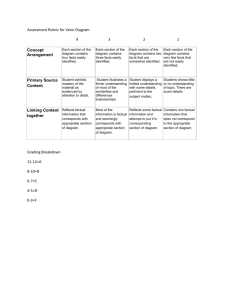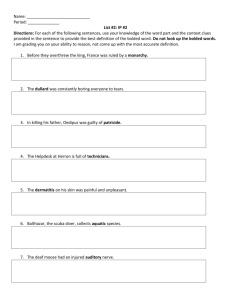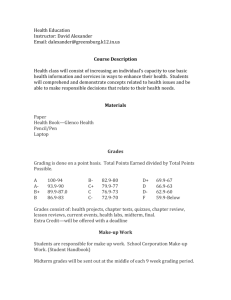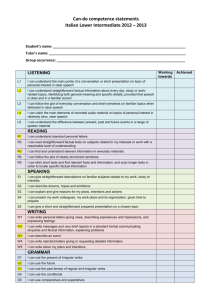Concept Map Instructions & Rubric
advertisement
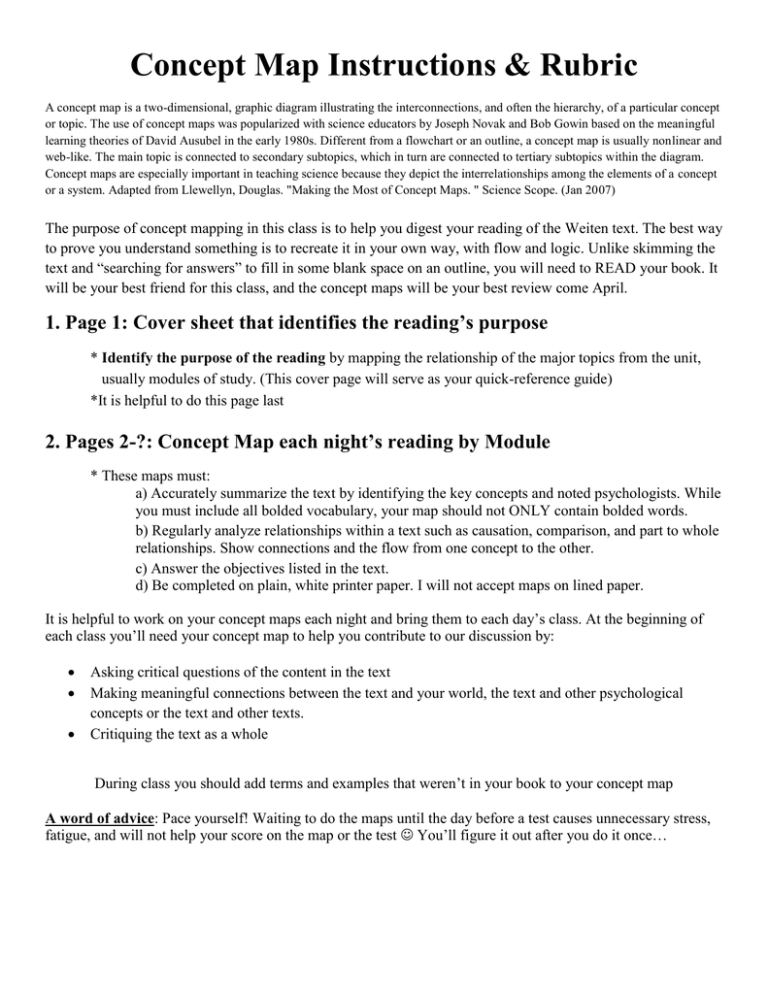
Concept Map Instructions & Rubric A concept map is a two-dimensional, graphic diagram illustrating the interconnections, and often the hierarchy, of a particular concept or topic. The use of concept maps was popularized with science educators by Joseph Novak and Bob Gowin based on the meaningful learning theories of David Ausubel in the early 1980s. Different from a flowchart or an outline, a concept map is usually nonlinear and web-like. The main topic is connected to secondary subtopics, which in turn are connected to tertiary subtopics within the diagram. Concept maps are especially important in teaching science because they depict the interrelationships among the elements of a concept or a system. Adapted from Llewellyn, Douglas. "Making the Most of Concept Maps. " Science Scope. (Jan 2007) The purpose of concept mapping in this class is to help you digest your reading of the Weiten text. The best way to prove you understand something is to recreate it in your own way, with flow and logic. Unlike skimming the text and “searching for answers” to fill in some blank space on an outline, you will need to READ your book. It will be your best friend for this class, and the concept maps will be your best review come April. 1. Page 1: Cover sheet that identifies the reading’s purpose * Identify the purpose of the reading by mapping the relationship of the major topics from the unit, usually modules of study. (This cover page will serve as your quick-reference guide) *It is helpful to do this page last 2. Pages 2-?: Concept Map each night’s reading by Module * These maps must: a) Accurately summarize the text by identifying the key concepts and noted psychologists. While you must include all bolded vocabulary, your map should not ONLY contain bolded words. b) Regularly analyze relationships within a text such as causation, comparison, and part to whole relationships. Show connections and the flow from one concept to the other. c) Answer the objectives listed in the text. d) Be completed on plain, white printer paper. I will not accept maps on lined paper. It is helpful to work on your concept maps each night and bring them to each day’s class. At the beginning of each class you’ll need your concept map to help you contribute to our discussion by: Asking critical questions of the content in the text Making meaningful connections between the text and your world, the text and other psychological concepts or the text and other texts. Critiquing the text as a whole During class you should add terms and examples that weren’t in your book to your concept map A word of advice: Pace yourself! Waiting to do the maps until the day before a test causes unnecessary stress, fatigue, and will not help your score on the map or the test You’ll figure it out after you do it once… Concept Map Rubric Content Organization Imagery Cogency Below Standard 2 Inadequate 0 Exceeds Standard 4 Meets Standard 3 -Contains an exhaustive coverage of the unit’s concepts (it is clear the student read & did not skim) -All bolded terms/noted psychologists are accentuated -Student elaborates beyond just the terms by providing digested (in your own words) definitions on the map -Concepts/people are taken from multiple class sources -Meaningful cover page with a map of the unit -Well-organized with a logical format and flow. -Expertly chunked, the main sections are clearly visible -One can quickly/clearly see logical relationships between terms/sections -Excellent use of visual layout (color & shapes/diagrams) to improve memory -Contains an extensive coverage of the unit’s concepts -Bolded terms/noted psychologists are highlighted -Concepts are mostly explained & elaborated upon by providing definitions on the map -Contains only a few of the main concepts -Map omits many smaller concepts/people -Map contains only concepts/terms with little explanation or elaboration -It is clear this was a last minute effort. -Is missing a significant number of concepts or modules. -Cover page with a map of the unit -Easy to follow most of the time -Well chunked, the main sections are mostly visible -One can see logical relationships between terms/sections -No cover page -Somewhat disorganized and jumbled -Little effort given to showing the division & connectedness of the content -No cover page -No effort given to breaking the content down into manageable chunks -Map is a visual mess which will be useless come May. -Use of visual layout (color & shapes) to improve memory -Does not use images or color to improve memory -Does not use images/shapes and color to improve memory. -Demonstrates mastery of the topic without factual error -Map meets all the above requirements without including useless clutter -Demonstrates mastery of the topic without significant factual error, or provides some incomplete statements -Makes a number of factual errors on the concept map, but can create a rough overview of the topic Student Score x8 _______ -Makes many critical factual errors on the concept map Concept Map Score: x7 ________ x6 _______ x4 ________
